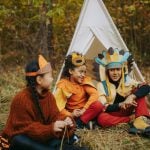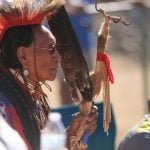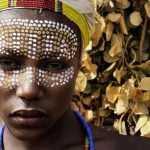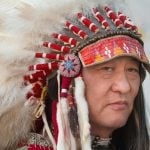Sacred Places in the Great Basin
The Great Basin is an area which includes the high desert regions between the Sierra Nevada and the Rocky Mountains. It is bounded on the north by the Columbia Plateau and on the south by the Colorado Plateau. It includes southern Oregon and Idaho, a small portion of southwestern Montana, western Wyoming, eastern California, all of Nevada and Utah, a portion of northern Arizona, and most of western Colorado. As with Indian people in other culture areas, there are many places in the Great Basin-water sources, hot springs, isolated rock formations, rock art sites, mountain peaks, and caves-which the Indian nations of this area consider to be sacred.

Water sources are traditionally seen as spiritual places and are often approached with requests for the spirits associated with them. In making these requests, Indian people traditionally leave offerings as a way of showing respect for the spiritual nature of these places.
Rock art sites-places which may include pictographs and/or petroglyphs-are often of great antiquity and are seen as places of great spiritual power. For the Northern and Eastern Shoshone, rock art was used to mark places of special spiritual power. Some of these were places where vision quests were commonly conducted.
At Big Spring in the Big Lost River Range of Idaho, the Shoshone have several pictographic panels which designate this as a sacred site. The area includes a water fall and the pictographs are selectively placed to focus on the sacred geography of the place. Some of the pictographic figures seem to indicate contact with the southwest, perhaps with the Hopi.
Jenny Lake in Grand Teton National Park in Wyoming is a sacred ceremonial area for the Shoshone. This is an area in which the Shoshone had traditionally held a Sun Dance. In 2000, acknowledging that a Sun Dance had not been held in this sacred location for 132 years, the Shoshone of the Wind River Reservation asked the National Park Service for permission to hold a Sun Dance on this sacred ground. The National Park Service, however, turned down the request, claiming that the ceremony would cause environmental action and that the Park did not have adequate resources for it.
At Dinwoody Canyon on the Wind River Reservation in Wyoming there are hundreds of pictographs which have been drawn over a long period of time. There are several large panels which have representations of the Water Ghost Beings and the Rock Ghost Beings. Some of the figures are obviously female, showing breasts and pubic fringe. The figures show that the spirit world includes female figures.
At Medicine Butte and Cedar Butte in Wyoming there are pictographs which are sacred to the Shoshone.
For the Eastern Shoshone in Wyoming, Bull Lake is also a sacred place for it is the home of monsters and it is the place where ghost people play the hand game. The lake, according to Shoshone tradition, houses a remarkable water buffalo. These are supernatural spirits which look like buffalo, but live in the lake. Seeing a water buffalo is considered to be a bad sign.
Mount Newberry in Nevada is called Avi Kwa Me or Spirit Mountain by the Mohave. This sacred mountain is the residence of Mutavilya and Mastahmo, the spirit teachers who instructed the Mohave people to be the caretakers of the river and the land.
Crowheart Butte in Wyoming is a spiritual place for the Shoshone. There are lots of good guardian spirits here. In 1866, the Shoshone and the Bannock fought a battle against the Crow here.
The Great Basin is a tectonically active region and has a number of hot springs. Hot springs are traditionally seen as a source of healing water and mud which can be used to relieve pain. For traditional Native Americans it is important to leave offerings at these healing waters and not to use them for recreation.
Pagosa Hot Springs in Colorado is sacred to the Ute for its ability to heal the sick. Smoking the sacred pipe at the springs is especially powerful.
Hot Springs in Wyoming is sacred to the Shoshone. According to some oral traditions, the Shoshone were warned to stay away from the springs by the Nimimbe (a race of dwarfish mountain people). The spring, according to the Nimimbe, is home to monstrous serpents.
South Fork Canyon of the Little Wind River contains a deep cave where the Shoshone traditionally buried their dead.
Yucca Mountain in Nevada is sacred to the Shoshone. In 2002, it was designated as the site of a storage facility for dangerous nuclear waste. In making the decision to use this site the tribe was not consulted by the U.S. government. The plan for the nuclear waste repository was scrapped in 2010. Under the 1863 Treaty of Ruby Valley, the Shoshone still claim ownership of this sacred site.
Parowan Gap in southern Utah is sacred to the Paiute. The gap was used as a solar calendar to mark the beginnings of the seasons. Petroglyphs etched into the rocks around the gap convey the spiritual significance of the area.
Old Man Mountain is an isolated rock formation in Colorado. This is a vision quest site that has been used for more than 3,000 years.
Cave Rock near Lake Tahoe in Nevada is sacred to the Washo. In 2000, the Forest Service began to allow rock climbing on this sacred formation.
In spite of a century of propaganda to the contrary, there are many sacred places in present-day Yellowstone National Park. The Shoshone, for example, would seek spiritual help from the geysers. Bathing in the waters of the geysers was a way of enhancing one’s spiritual power.
One of the continuing problems facing sacred sites in the Great Basin is vandalism and looting by non-Indians. In 2010, the Shoshone-Paiute tribes of the Duck Valley Reservation began flying helicopters to keep watch on important culture sites and to prevent vandalism and looting. The sites include vision quest sites as well as ancient fishing sites, burial grounds, and other sacred areas.
The Ute often used stone circles as a part of their ceremonies. The Ute traditionally used these stone circles as individual ritual sites and they are still considered sacred today. There was not a standardized way of using these stone circles. Each of the spiritual leaders had their own ceremonies and their own way of using the circles.
Among the Southern Ute, there are supernatural powers associated with the land. Spiritual leaders for each band would go to specific “power points” to leave offerings and to ask for help on behalf of the band. Tribal members feel that the location of these power sites should not be general knowledge. The locations of these sites and the powers which they contain should be discussed only with those who have a need to know. Knowledge of these sites is to be passed on through oral traditions and should not be transmitted through writing.
Due to the spiritual nature of these sites and in respect to the tribal elders, no photographs of them have been used in this essay.



